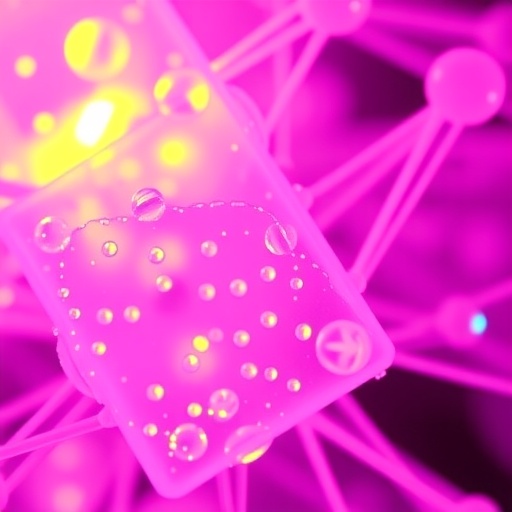In a groundbreaking research effort addressing the burgeoning crisis of plastic waste, a team of scientists has developed an innovative catalyst composed of nickel-substituted polyoxometalates combined with cadmium sulfide (Ni-POM@CdS). This pioneering work, led by Professor Zhi-Ming Zhang from Tianjin University of Technology, seeks not only to tackle the enormous challenge of plastic pollution but also to produce hydrogen, a cleaner and renewable energy source, in a single, efficient process.
Plastic waste management is increasingly recognized as a critical global issue, with less than 10% of the nearly 400 million tons of plastic produced yearly being recycled. The predominant approaches of incineration and landfilling contribute to environmental hazards, leading to an urgent need for novel solutions. Recognizing the severity of the situation, Zhang’s team has engineered a catalyst that enables the dual function of degrading polylactic acid (PLA)—a widely used biodegradable plastic—and producing hydrogen gas, which can be utilized as a fuel source.
The research highlights the unique properties of the Ni-POM@CdS catalyst, particularly its remarkable photocatalytic efficiency in facilitating the evolution of hydrogen. What’s particularly striking is the electrochemical mechanism underlying this process. The team uncovered that the nickel polyoxometalate clusters exhibit an “electron sponge” effect, drastically enhancing the separation efficiency of charge carriers. This pivotal finding explains why the Ni-POM@CdS catalyst vastly outperformed pristine CdS in hydrogen generation activities.
Central to this innovation is the meticulous preparation of the Ni-POM clusters. By employing an impregnation method, the researchers ensured a uniform distribution of Ni-POM clusters ranging from 1.4 to 2.0 nm on the surface of cadmium sulfide nanospheres. This uniformity, confirmed by high-resolution transmission electron microscopy (HRTEM) and elemental mapping, plays a critical role in optimizing photocatalytic performance.
Spectroscopic analyses, including X-ray photoelectron spectroscopy (XPS) and photoluminescence (PL) studies, substantiated the researchers’ assertion that the Ni₉ cluster possesses exceptional properties for rapid electron capture. This ability significantly mitigates charge recombination, extending the lifetimes of holes required for the oxidation of PLA. The catalysis mechanism operates such that photogenerated electrons are captured by the Ni-POM component to facilitate hydrogen evolution, while simultaneously, the surface holes engage in the oxidation of the plastic waste.
Impressively, the study reported that the Ni₉@CdS-10 catalyst attained a staggering 160-fold enhancement in hydrogen evolution compared to unmodified CdS, demonstrating not only efficiency but also robustness over extended operational periods. The catalyst maintained its structural integrity and function even after 50 hours of continuous operation, highlighting its potential for practical applications in waste management and renewable energy production.
The implications of this research extend beyond merely addressing plastic degradation and hydrogen production. It aligns with the principles of waste valorization, converting hazardous waste into valuable resources, thus enhancing the economic viability of the process. The team’s approach produces pyruvate—a chemical with considerable market value—as a byproduct, setting the stage for commercial applications.
The research team is already contemplating the scaling of this technology for real-world applications. The versatility of the Ni-POM@CdS catalyst opens avenues for its use in microplastic remediation in freshwater environments, suggesting its potential to not only clear pollutants but also contribute to greener energy initiatives. As the urgency for sustainable solutions intensifies, this novel catalytic system could play a critical role in a future where waste processing and energy generation are intertwined.
The collaborative effort in this research also underscores the synergy between various institutions, including contributions from Tiangong University and the Institute of General and Inorganic Chemistry of the Russian Academy of Sciences. The extensive support from the National Natural Science Foundation of China illustrates the importance of facilitating interdisciplinary research aimed at solving pressing environmental issues.
In conclusion, the advancements represented by the Ni-POM@CdS catalyst signify a substantial leap in material science and environmental chemistry. As researchers delve deeper into optimizing these catalytic systems, the potential to generate hydrogen while tackling plastic waste signifies a promising path towards sustainable energy and responsible waste management. The future is ripe with possibilities as we seek to reconcile our energy needs with environmental stewardship.
Subject of Research: Development of Ni-POM@CdS photocatalysts for plastic waste degradation and hydrogen production.
Article Title: Nickel-substituted polyoxometalate-CdS single-cluster photocatalysts for efficient plastic waste degradation coupled with H2 production.
News Publication Date: 28-Jul-2025.
Web References:
References:
Image Credits: Credit: Polyoxometalates, Tsinghua University Press
Keywords
Plastic waste management, photocatalysis, hydrogen production, polyoxometalates, sustainable energy, waste valorization, material science, environmental chemistry.
Tags: cadmium sulfide photocatalystsdual-function catalysts for energy and wasteelectrochemical mechanisms in catalysisenvironmental pollution solutionshydrogen production catalystsinnovative waste management technologiesnickel-substituted polyoxometalatesphotocatalytic efficiencyplastic waste degradationpolylactic acid degradationRenewable energy solutionssustainable plastic recycling methods





